tires TOYOTA PRIUS PLUG-IN 2014 Owners Manual
[x] Cancel search | Manufacturer: TOYOTA, Model Year: 2014, Model line: PRIUS PLUG-IN, Model: TOYOTA PRIUS PLUG-IN 2014Pages: 724, PDF Size: 20.28 MB
Page 54 of 724
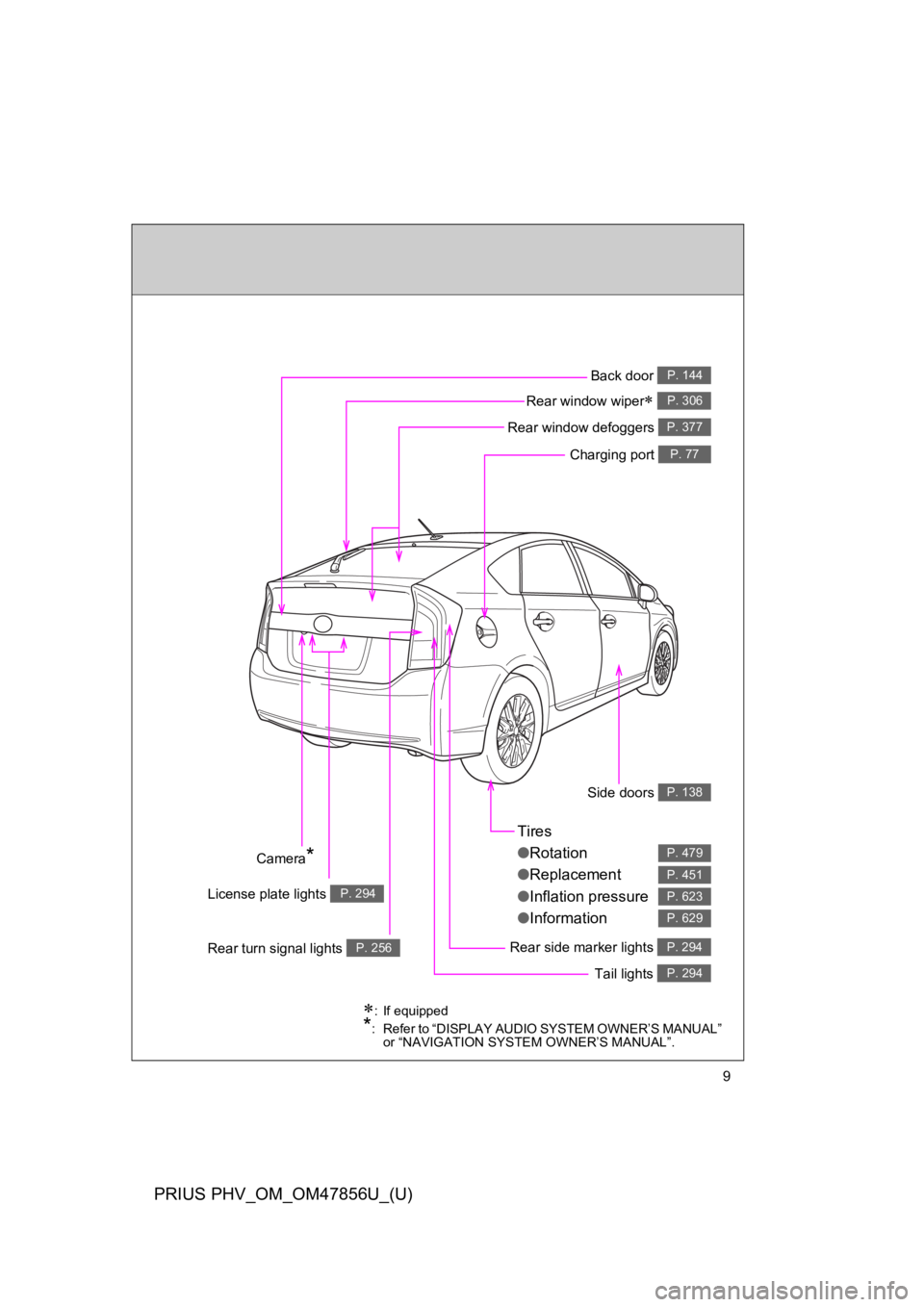
9
PRIUS PHV_OM_OM47856U_(U)
Tires
●Rotation
●Replacement
●Inflation pressure
●Information
P. 479
P. 451
P. 623
P. 629
Rear side marker lights P. 294
Side doors P. 138
Tail lights P. 294
∗:If equipped
*:Refer to “DISPLAY AUDIO SYSTEM OWNER’S MANUAL” or “NAVIGATION SYSTEM OWNER’S MANUAL”.
Rear turn signal lights P. 256
License plate lights P. 294
Camera*
Back door P. 144
Rear window wiper∗ P. 306
Rear window defoggers P. 377
Charging port P. 77
Page 112 of 724
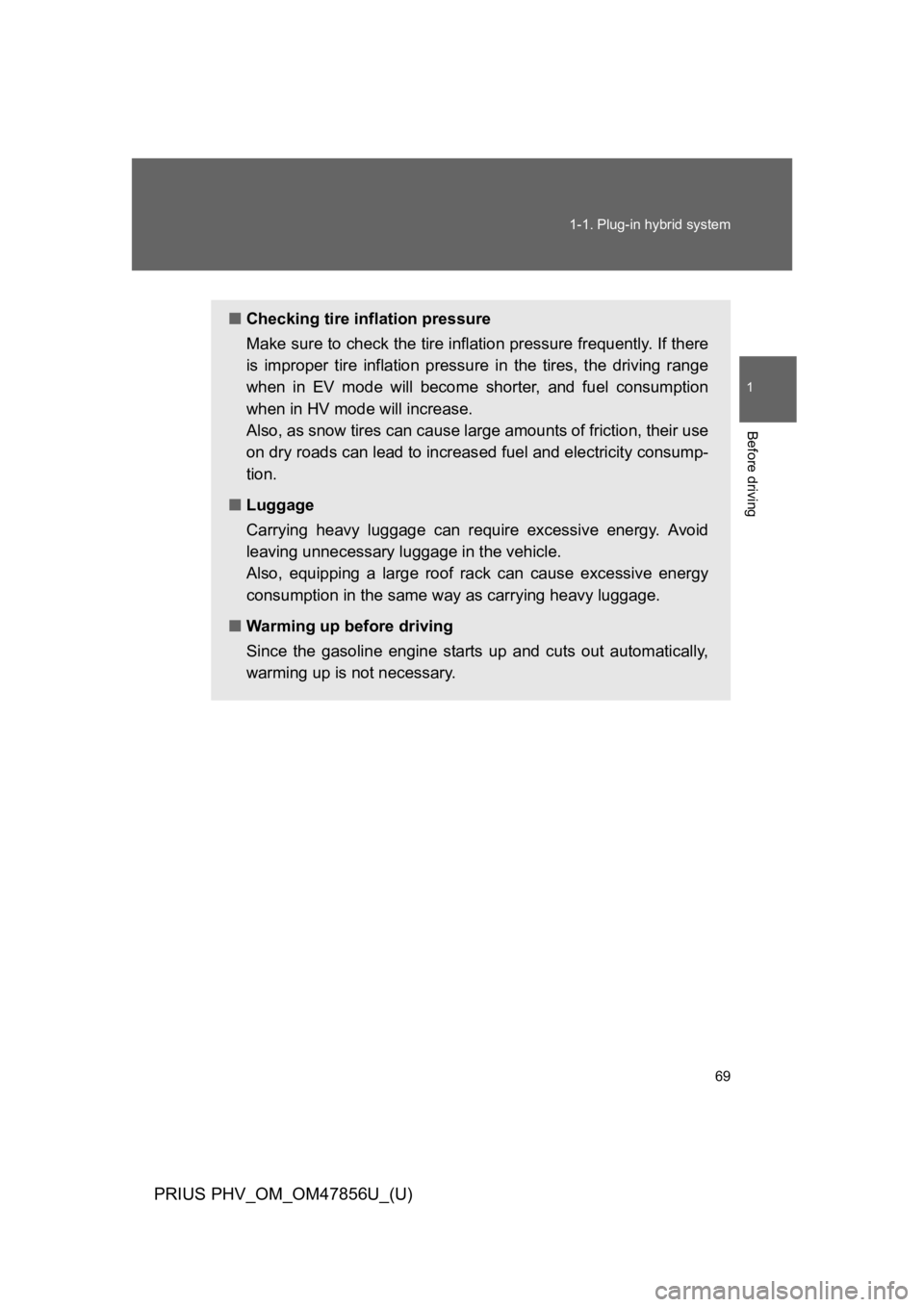
69
1-1. Plug-in hybrid system
1
Before driving
PRIUS PHV_OM_OM47856U_(U)
■Checking tire inflation pressure
Make sure to check the tire inflation pressure frequently. If there
is improper tire inflation pressure in the tires, the driving range
when in EV mode will become shorter, and fuel consumption
when in HV mode will increase.
Also, as snow tires can cause large amounts of friction, their use
on dry roads can lead to increased fuel and electricity consump-
tion.
■Luggage
Carrying heavy luggage can require excessive energy. Avoid
leaving unnecessary luggage in the vehicle.
Also, equipping a large roof rack can cause excessive energy
consumption in the same way as carrying heavy luggage.
■Warming up before driving
Since the gasoline engine starts up and cuts out automatically,
warming up is not necessary.
Page 115 of 724

72
1-1. Plug-in hybrid system
PRIUS PHV_OM_OM47856U_(U)
Tips for extending the distance that can be driven in EV mode
The distance that can be driven in EV mode varies significantly depend-
ing on how the vehicle is driven, road conditions, the weather, the out-
side temperature, usage conditions of electrical components and the
number of occupants.
The distance that can be driven in EV mode can be extended if the fol-
lowing is performed:
●Maintain a safe distance from the vehicle in front and avoid unneces-
sary acceleration and deceleration
●Accelerate and decelerate the vehicle as smoothly as possible
●Drive at moderate speeds as much as possible and maintain a con-
stant speed
●Set the air conditioning to a moderate temperature and turn the air
conditioning system off when it is not needed
●Use tires of the specified size and maintain the specified tire pressure
●Use the EV/HV mode selection switch to drive in HV mode when driv-
ing on a highway
Electricity consumption will increase substantially when driving on a
highway in EV mode.
●Do not add unnecessary weight to the vehicle
Page 270 of 724

228
2-1. Driving procedures
PRIUS PHV_OM_OM47856U_(U)
■When starting off on a uphill
The hill-start assist control is available. (→P. 3 3 5 )
■Driving in the rain
●Drive carefully when it is raining, because visibility will be reduced, the
windows may become fogged-up, and the road will be slippery.
●Drive carefully when it starts to rain, because the road surface will be
especially slippery.
●Refrain from high speeds when driving on an expressway in the rain,
because there may be a layer of water between the tires and the road
surface, preventing the steering and brakes from operating properly.
■Breaking in your new Toyota
To e x t e n d t h e l i f e o f t h e v e h i c l e , o b s e r v i n g t h e f o l l o w i n g p r e c a u t i o n s i s r e c -
ommended:
●For the first 200 miles (300 km):
Avoid sudden stops.
●For the first 600 miles (1000 km):
•Do not drive at extremely high speeds.
•Avoid sudden acceleration.
•Do not drive at a constant speed for extended periods.
Page 274 of 724

232
2-1. Driving procedures
PRIUS PHV_OM_OM47856U_(U)
CAUTION
●Do not adjust the positions of the steering wheel, the seat, or the inside or
outside rear view mirrors while driving.
Doing so may result in a loss of vehicle control that can cause accidents,
resulting in death or serious injury.
●Always check that all passengers’ arms, heads or other parts of their body
are not outside the vehicle, as this may result in death or serious injury.
●Do not drive in excess of the speed limit. Even if the legal speed limit per-
mits it, do not drive over 85 mph (140 km/h) unless your vehicle has high-
speed capability tires. Driving over 85 mph (140 km/h) may result in tire
failure, loss of control and possible injury. Be sure to consult a tire dealer
to determine whether the tires on your vehicle are high-speed capability
tires or not before driving at such speeds.
■When driving on slippery road surfaces
●Sudden braking, acceleration and steering may cause tire slippage and
reduce your ability to control the vehicle, resulting in an accident.
●Sudden acceleration, engine braking due to shift changing, or changes in
engine speed could cause the vehicle to skid, resulting in an accident.
●After driving through a puddle, depress the brake pedal to make sure that
the brakes are functioning properly. Wet brake pads may prevent the
brakes from functioning properly. If the brakes on only one side are wet
and not functioning properly, steering control may be affected, resulting in
an accident.
Page 375 of 724

333
2-4. Using other driving systems
PRIUS PHV_OM_OM47856U_(U)
2
When driving
CAUTION
■The ABS does not operate effectively when
●The limits of tire gripping performance have been exceeded (such as
excessively worn tires on a snow covered road).
●The vehicle hydroplanes while driving at high speed on wet or slick road.
■Stopping distance when the ABS is operating may exceed that of nor-
mal conditions
The ABS is not designed to shorten the vehicle’s stopping distance. Always
maintain a safe distance from the vehicle in front of you, especially in the fol-
lowing situations:
●When driving on dirt, gravel or snow-covered roads
●When driving with tire chains
●When driving over bumps in the road
●When driving over roads with potholes or uneven surfaces
■TRAC may not operate effectively when
Directional control and power may not be achievable while driving on slip-
pery road surfaces, even if the TRAC system is operating.
Drive the vehicle carefully in conditions where stability and power may be
lost.
■When the VSC is activated
The slip indicator light flashes. Always drive carefully. Reckless driving may
cause an accident. Exercise particular care when the indicator light flashes.
Page 376 of 724

334
2-4. Using other driving systems
PRIUS PHV_OM_OM47856U_(U)
CAUTION
■Replacing tires
Make sure that all tires are of the specified size and of the same brand, tread
pattern and total load capacity. In addition, make sure that the tires are
inflated to the recommended tire inflation pressure level.
The ABS and VSC systems will not function correctly if different tires are
installed on the vehicle.
Contact your Toyota dealer for further information when replacing tires or
wheels.
■Handling of tires and the suspension
Using tires with any kind of problem or modifying the suspension will affect
the driving assist systems, and may cause a system to malfunction.
Page 392 of 724
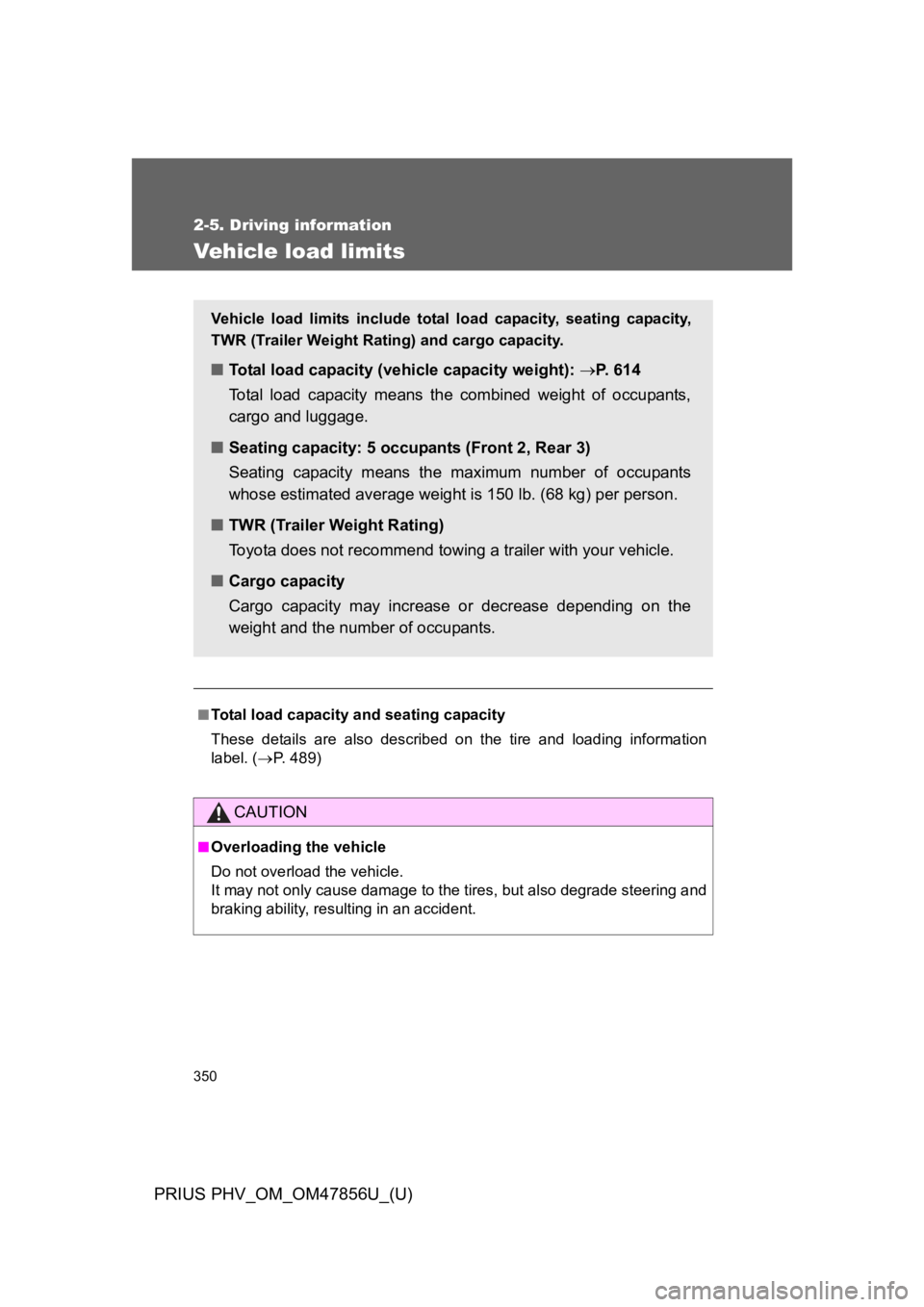
350
2-5. Driving information
PRIUS PHV_OM_OM47856U_(U)
Ve h i cl e l o a d l i m i t s
■To ta l l o a d c a pa c i t y a n d s e a t i n g c a pa c i t y
These details are also described on the tire and loading information
label. (→P. 4 8 9 )
CAUTION
■Overloading the vehicle
Do not overload the vehicle.
It may not only cause damage to the tires, but also degrade steering and
braking ability, resulting in an accident.
Ve h i c l e l oa d l i m i ts i n c l u d e t o ta l l o a d c a pa c i t y, s e a t i ng c a pa c i t y,
TWR (Trailer Weight Rating) and cargo capacity.
■To ta l l o a d c a pa c i t y ( v e h i c l e c a pa c i t y w e i g h t ) : →P. 6 1 4
To t a l l o a d c a p a c i t y m e a n s t h e c o m b i n e d w e i g h t o f o c c u p a n t s ,
cargo and luggage.
■Seating capacity: 5 occupants (Front 2, Rear 3)
Seating capacity means the maximum number of occupants
whose estimated average weight is 150 lb. (68 kg) per person.
■TWR (Trailer Weight Rating)
To y o t a d o e s n o t r e c o m m e n d t o w i n g a t r a i l e r w i t h y o u r v e h i c l e .
■Cargo capacity
Cargo capacity may increase or decrease depending on the
weight and the number of occupants.
Page 393 of 724
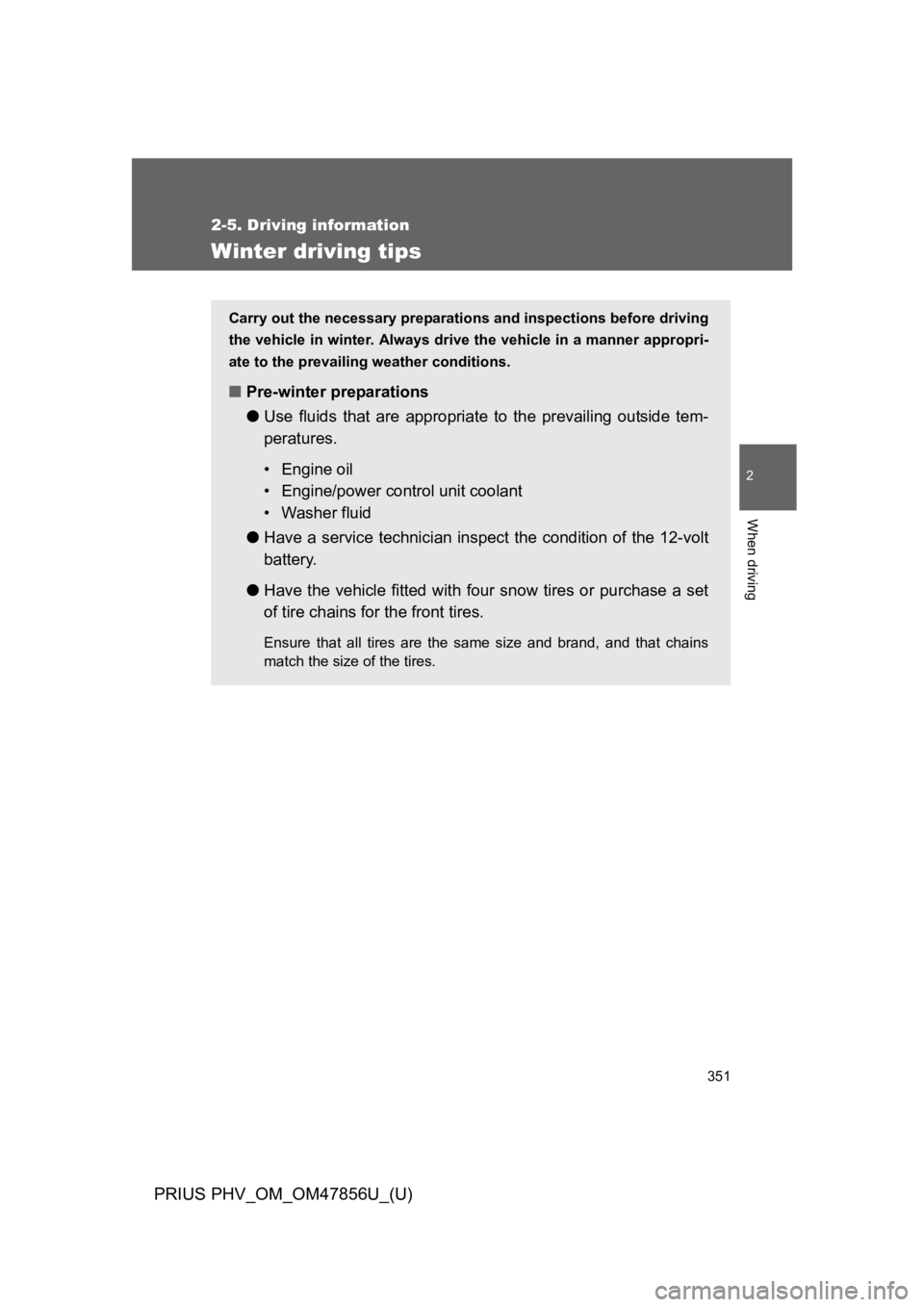
351
2-5. Driving information
PRIUS PHV_OM_OM47856U_(U)
2
When driving
Winter driving tips
Carry out the necessary preparations and inspections before driving
the vehicle in winter. Always drive the vehicle in a manner appropri-
ate to the prevailing weather conditions.
■Pre-winter preparations
●Use fluids that are appropriate to the prevailing outside tem-
peratures.
•Engine oil
•Engine/power control unit coolant
•Washer fluid
●Have a service technician inspect the condition of the 12-volt
battery.
●Have the vehicle fitted with four snow tires or purchase a set
of tire chains for the front tires.
Ensure that all tires are the same size and brand, and that chains
match the size of the tires.
Page 394 of 724
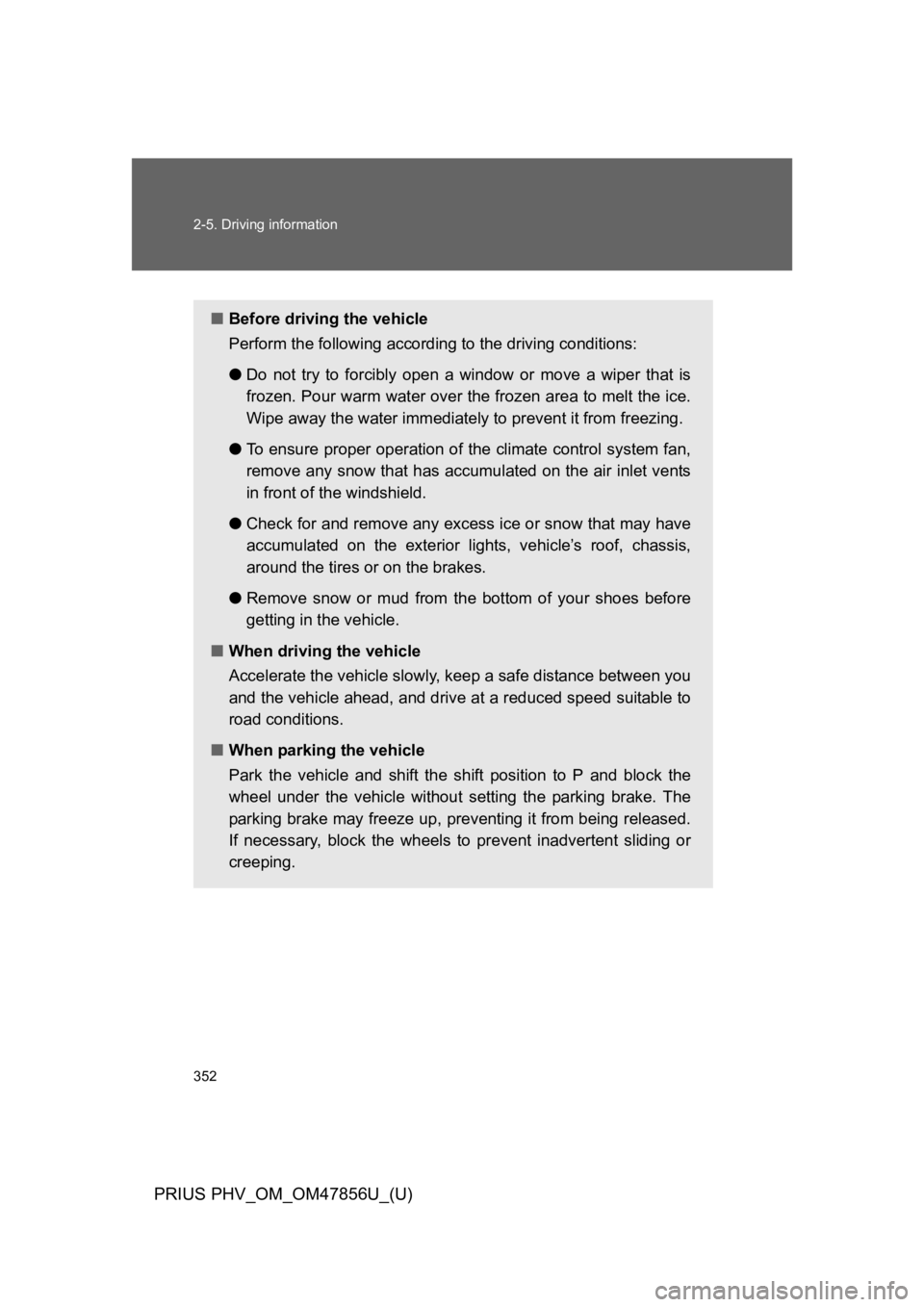
352
2-5. Driving information
PRIUS PHV_OM_OM47856U_(U)
■Before driving the vehicle
Perform the following according to the driving conditions:
●Do not try to forcibly open a window or move a wiper that is
frozen. Pour warm water over the frozen area to melt the ice.
Wipe away the water immediately to prevent it from freezing.
●To e n s u r e p r o p e r o p e r a t i o n o f t he climate control system fan,
remove any snow that has accumulated on the air inlet vents
in front of the windshield.
●Check for and remove any excess ice or snow that may have
accumulated on the exterior lights, vehicle’s roof, chassis,
around the tires or on the brakes.
●Remove snow or mud from the bottom of your shoes before
getting in the vehicle.
■When driving the vehicle
Accelerate the vehicle slowly, keep a safe distance between you
and the vehicle ahead, and drive at a reduced speed suitable to
road conditions.
■When parking the vehicle
Park the vehicle and shift the shift position to P and block the
wheel under the vehicle without setting the parking brake. The
parking brake may freeze up, preventing it from being released.
If necessary, block the wheels to prevent inadvertent sliding or
creeping.